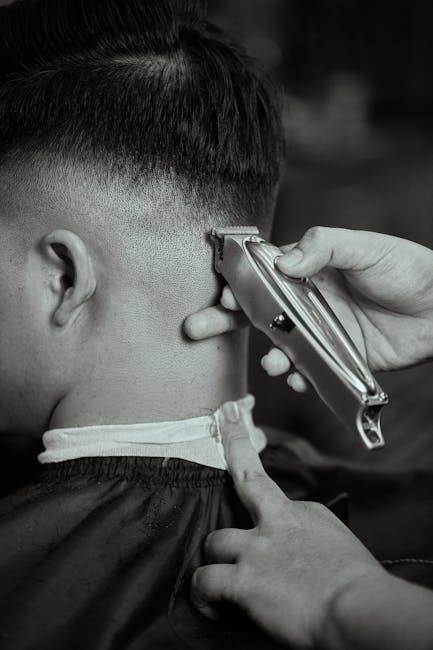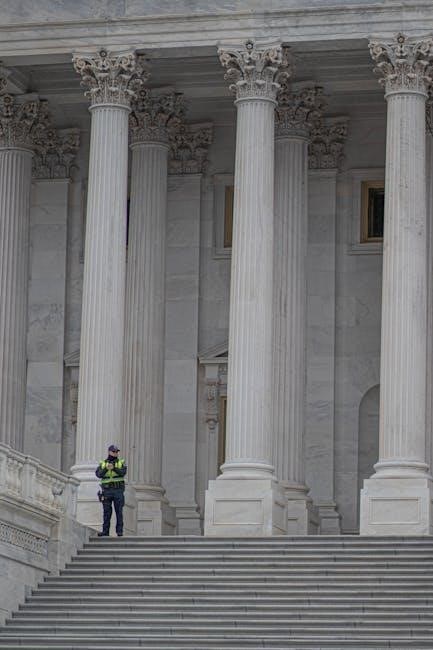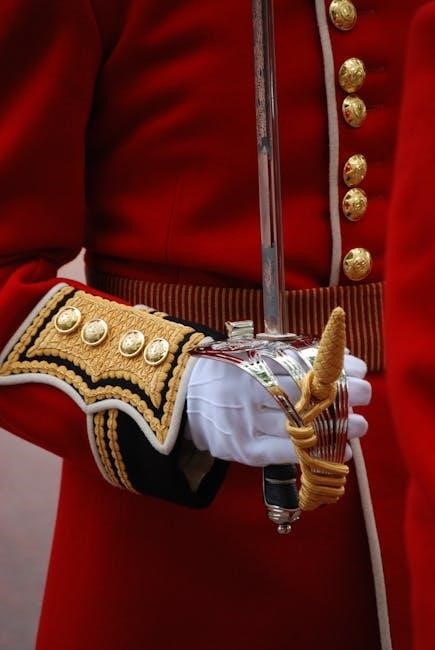
clipper guard guide
Clipper guards are essential attachments that control hair length, ensuring even cuts. Available in various sizes, they guide hair evenly toward blades, making precise styling effortless. Crucial for maintaining evenness and style in haircuts, they are indispensable for both professionals and home users.
1.1 What Are Clipper Guards?
Clipper guards are attachments designed to regulate the length of hair being cut. They feature teeth that guide hair evenly toward the blades, ensuring precise, uniform cuts. Available in numbered sizes, these guards determine how close the clippers will cut to the scalp or skin. By controlling the cutting length, they prevent hair from being cut too short, making them essential for achieving specific hairstyles. Whether for fades, buzz cuts, or trims, clipper guards are a crucial tool for both professionals and home users.
1.2 Importance of Clipper Guards in Haircuts
Clipper guards are vital for achieving precise, even haircuts. They prevent uneven cuts by maintaining consistent hair length, ensuring a professional finish. Guards also protect the scalp from direct blade contact, reducing the risk of cuts or irritation. By using the right guard size, individuals can achieve specific styles, such as fades or buzz cuts, with ease. This makes clipper guards indispensable for both professional barbers and home users, ensuring safe and effective hair cutting experiences.
How Clipper Guards Work
Clipper guards guide hair evenly toward blades, ensuring precise cuts. The guard’s teeth comb through hair, while the clipper lever adjusts blade height, determining cut length. This mechanism ensures even, safe trimming, preventing direct blade contact with the scalp, and allows for consistent, professional results.
2.1 Mechanism of Clipper Guards
The mechanism of clipper guards involves their teeth combing through hair to regulate length. As clippers move, the guard ensures only hair exceeding the guard’s height reaches blades. This precise control allows for even trims. The guard’s design prevents blades from cutting too short, maintaining consistent results. Lever adjustments on clippers further refine cut lengths, offering versatility in styling. This combined system ensures accurate, uniform haircuts, making guards indispensable for both professionals and home users aiming for polished looks.
2.2 Role of the Clipper Lever
The clipper lever plays a crucial role in adjusting the cutting length. By moving the lever, the blade’s position changes, enabling precise control over hair length. When closed, the blade is closer to the scalp, cutting shorter hair, while an open lever allows for longer cuts. This mechanism works in tandem with the guard, offering versatility in achieving desired hairstyles. The lever’s adjustments refine the cutting process, ensuring accurate results without needing to change guards, making it a key tool for both professionals and home users.
2.3 Impact of Clippers Without Guard Attachments
Clippers without guards cut hair extremely short, often to 0.4mm, making them ideal for precise, close cuts. This setup is perfect for creating clean lines or shaving areas like the neckline. However, without guards, clippers can cause unevenness or irritation if not used carefully. They are best suited for experienced users or specific styling needs, as they require skill to achieve smooth, consistent results. Guards are recommended for most hairstyles to ensure evenness and protect the scalp during trimming.
Clipper Guard Sizes and Measurements
Clipper guards come in standard sizes, such as 1, 2, and 3, corresponding to specific hair lengths like 3mm, 6mm, and 10mm. These measurements ensure precise cuts, catering to various hairstyles and preferences. However, variations exist across brands, so understanding the size system is crucial for achieving desired results. Proper sizing is key to maintaining evenness and style in haircuts.
3.1 Standard Guard Sizes and Their Uses
Standard clipper guard sizes range from 0 to 8, measuring hair length in millimeters. A size 0 guard trims hair closely, while larger sizes like 4 or 8 leave more length. These guards are ideal for various styles, such as buzz cuts, fades, and trims. For instance, a size 3 guard is perfect for medium-length cuts, ensuring uniformity and precision. Understanding each size’s purpose helps in achieving the desired hairstyle efficiently, whether for personal use or professional barbering.
3.2 Variations in Guard Size Systems Across Brands
Clipper guard sizes vary across brands, leading to confusion. Some brands use numeric systems, while others incorporate letters (e.g., A, C, E), altering the length measurements. For instance, a size 1 guard might equate to 3mm with one brand but differ with another. These inconsistencies require users to familiarize themselves with specific brand guidelines to ensure accurate cuts. Understanding these variations is crucial for achieving the desired haircut and avoiding mismatches in length settings.
3.3 How to Read and Choose the Right Guard Size
Understanding guard sizes is crucial for precise haircuts. Most guards are marked with numbers or letters, indicating hair length. Start by referencing the brand’s size chart, as measurements vary. For example, a size 1 guard might be 3mm with one brand and 4mm with another. Begin with a larger guard to avoid cutting too short, then adjust as needed. For layering, the 3-2-1 rule is popular, using different guards for top, mid, and lower sections. Always test on a small area first to ensure accuracy.

Popular Hairstyles Using Clipper Guards
Clipper guards enable precise styles like buzz cuts, fades, and even trims. They help achieve uniform length, making them ideal for maintaining clean, modern looks effortlessly at home.
4.1 Buzz Cuts and Guard Sizes
Buzz cuts rely on clipper guards to achieve consistent length. Guards 0-3 are typically used for short styles, while a #4 guard offers a slightly longer look. The key is to maintain uniformity across the scalp. For a more defined appearance, barbers often use lower guard sizes around the ears and neck. Proper guard selection ensures a clean finish, making buzz cuts a timeless choice for simplicity and style.
4.2 Fading Techniques with Clipper Guards
Fading techniques with clipper guards involve creating seamless transitions between hair lengths. Guards are used to define the shortest point of the fade, while the adjustable lever fine-tunes the length. Start with a lower guard size (e.g., #0 or #1) around the temples and neck for a sharp contrast. Gradually increase the guard size as you move upward to blend the fade naturally. This method ensures a polished, professional-looking fade without noticeable lines or unevenness.
4.3 Achieving Even Trims and Layered Looks
Clipper guards are indispensable for achieving even trims and layered hairstyles. By using the same guard size across the head, you ensure uniformity in length, creating a neat, consistent look. For layered styles, switch between guard sizes to define different sections. Start with a shorter guard for the lower areas and gradually increase the size for upper layers. This technique allows for a natural transition between lengths, resulting in a balanced, professional-looking haircut with depth and dimension.

Maintenance and Care of Clipper Guards
Regularly clean and store clipper guards to maintain their efficiency. Replace worn-out guards to ensure precise cuts and prolong their lifespan for optimal performance.
5.1 Cleaning and Storing Clipper Guards
Cleaning clipper guards is essential for maintaining hygiene and performance. Use a soft brush to remove hair clippings and gentle cleaning products to sanitize them. Store guards in a dry place or protective case to prevent damage and rust. Regular maintenance ensures longevity and optimal functionality during haircuts, keeping your tools in top condition for precise cuts every time.
5.2 Replacing Worn-Out Guards
Regularly inspect clipper guards for wear, such as dull teeth or bent edges. Replace them immediately if damage is found to ensure even cuts. Worn guards can lead to uneven trims and scalp irritation. Replacing them maintains the quality of your haircuts and extends the life of your clippers. Always purchase high-quality replacements compatible with your clipper model for optimal performance and safety during use.

Troubleshooting Common Issues
Common issues include uneven cuts and guard misalignment. Check for worn or bent guards and ensure proper attachment. Adjust or replace faulty parts for consistent results.
6.1 Uneven Cuts and Guard Adjustment
Uneven cuts often result from improper guard alignment or incorrect size selection. Ensure the guard is securely attached and aligned with the blade. Adjust the lever to match the guard size for consistent results. Check for bent or worn guards, as they can disrupt even cutting. Clean the clippers and guards regularly to maintain precision. For optimal performance, use the correct guard for your desired hair length and technique. Proper adjustment and maintenance are key to achieving smooth, even haircuts every time.
6.2 Guard Compatibility with Different Clippers
Clipper guards may not be universally compatible across all brands or models due to varying size systems. Always check compatibility before purchasing, as some guards are designed for specific clippers. Using the wrong guard can lead to poor performance or damage to the clippers. Adjustments may be needed if the guard fits loosely or tightly. Ensure a secure fit to maintain even cutting and prevent potential issues. Proper compatibility ensures optimal performance and precise results.

Advanced Techniques with Clipper Guards
Advanced techniques involve precision fades and layered styles. Use guards to create seamless transitions, ensuring smooth blending. Experiment with different guard combinations for unique looks. Adjust the clipper lever to refine cuts further, achieving precise control. These methods elevate your haircutting skills, offering professional-grade results at home. With practice, master intricate designs and customizable styles effortlessly.
7.1 Using Guards for Precision Fades
Precision fades require mastering clipper guards. Start with a shorter guard for the neckline, blending into longer guards as you move upward; Use the clipper lever to adjust blade exposure, creating seamless transitions. For a natural look, work slowly, feathering the edges. Combining guards of varying sizes allows for gradual length changes, ensuring a smooth fade. Practice controlling the angle and pressure to achieve professional results. This technique is key for modern, polished hairstyles, enhancing both definition and style seamlessly.
7.2 Combining Guards for Layered Hairstyles
Combining clipper guards creates layered, dimensional hairstyles. Start with a shorter guard for the underside, then switch to longer guards for upper sections. This technique allows for gradual length transitions, adding texture and depth. For example, use a #2 guard for the lower half and a #4 guard for the top. Blend the layers by overlapping the guards slightly. This method ensures a natural, seamless look. Layering with guards enhances versatility, making it ideal for both casual and formal styles, while maintaining a polished finish.

Tools and Accessories for Clipper Guards
Essential tools include storage cases, cleaning brushes, and oil for maintenance. These accessories ensure longevity and optimal performance of your clipper guards, enhancing haircut precision and ease.
8.1 Essential Accessories for Home Haircuts
For home haircuts, essential accessories include storage cases to organize guards, cleaning brushes to remove hair clippings, and oil to maintain clipper performance. A comb or brush ensures even sectioning, while a mirror provides clear visibility. These tools enhance precision and convenience, making home grooming efficient and effective. Proper maintenance of these accessories ensures longevity and optimal results, helping you achieve professional-quality cuts with ease.
8.2 Professional-Grade Clipper Guards
Professional-grade clipper guards are designed for durability and precision, offering superior performance for barbers and stylists. High-quality guards are typically made from metal, ensuring longevity and consistent cuts. They often feature precise sizing and secure fits, reducing the risk of uneven trims. Premium brands like Wahl and Andis offer guards with advanced coatings to prevent rust and corrosion. These guards are ideal for heavy use, delivering accurate results and maintaining their performance over time, making them a worthwhile investment for professionals.

Clipper Guard Guide for Different Hair Types
Clipper guards are essential for different hair types, ensuring precise cuts without damage. They help manage thick, coarse, or fine hair, guiding clippers for even trims.
9.1 Guards for Thick or Coarse Hair
Clipper guards are vital for managing thick or coarse hair, ensuring even cuts without damage. Larger guard sizes are recommended to handle denser hair effectively, preventing split ends and breakage. Metal guards are often preferred for their durability and ability to glide smoothly through thick strands, maintaining an even length and reducing pulling. This makes them ideal for achieving precise, professional-looking trims on coarser hair textures.
9.2 Guards for Fine or Thin Hair
For fine or thin hair, clipper guards are crucial to avoid overly thinning the hair. Smaller guard sizes are recommended to maintain volume and prevent a sparse appearance. Guards with finer teeth are ideal, as they handle delicate strands gently. Using a lighter touch and smaller guard sizes helps create a natural, even look without compromising the hair’s density. This approach ensures a more flattering and balanced haircut for finer hair textures.